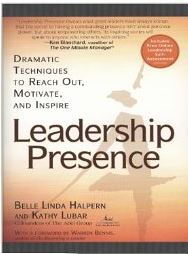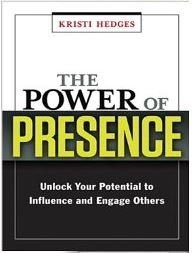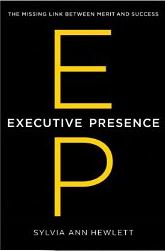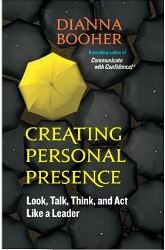Developing Leadership Presence
Presence, whether you call it executive, leadership or personal presence, is becoming the new corporate “it” factor. Apparently the topic covers a lot of ground, as you can imagine.
Here are my recommendations for best books:
- Leadership Presence: Dramatic Techniques to Reach Out, Motivate and Inspire, by Kathy Lubar and Belle Linda Halpern (Penguin Group, 2004)
- The Power of Presence: Unlock Your Potential to Influence and Engage Others, by Kristi Hedges (Amacom, 2012)
- Executive Presence: The Missing Link Between Merit and Success, by Sylvia Ann Hewlett (HarperBusiness, 2014)
- Creating Personal Presence: Look, Talk, Think, and Act Like a Leader, Dianna Booher (BK Life, 2011)
Leadership Presence by Lubar and Halpern
 This was the second book I read on presence. Previously I had read the book by Harrison Monarth: Executive Presence: The Art of Commanding Respect Like a CEO (McGraw-Hill, 2009).
This was the second book I read on presence. Previously I had read the book by Harrison Monarth: Executive Presence: The Art of Commanding Respect Like a CEO (McGraw-Hill, 2009).
(I had written an article, “How to Cultivate Executive Presence,” back in February 2011, based on this book and it’s available for purchase to use in your blogs and newsletters.)
I came by the Leadership Presence book at a time I was participating in a summer actors’ workshop for our local Little Theater. The book is written by two former actresses, who now train leaders in presence. Many of the guidelines for acting are helpful for leaders, in surprising ways.
This book is full of reasons why, none of them as superficial as you might think. For example, in a play, the actors put themselves in a mindset of clearly knowing what they are fighting for and what the obstacles are. That mindset is apparent in their faces, voices, and demeanors.
Leaders can learn to use similar techniques, whether presenting to a large group or individuals. They must learn to express their passion and reveal their emotions if they are to gain influence for their ideas and plans.
The authors suggest the PRES model for developing leadership presence:
P = Presence: the ability to be completely in the moment and flexible enough to handle the unexpected
R = Reaching Out: the ability to build relationships with others through empathy, listening and authentic connection
E = Expressiveness: the ability to express feelings and emotions appropriately by using all available means (words, voice, body, face) to deliver one congruent message
S = Self-Knowing: the ability to accept yourself, be authentic and reflect your values in your decisions and actions
I based the September 2014 article “Emotional Expressiveness for Leaders,” on the concepts found in this book. It’s available here.
The Power of Presence by Kristi Hedges
 This was perhaps my favorite book both for the intelligent way it is written and for the author’s profound understanding of the topic.
This was perhaps my favorite book both for the intelligent way it is written and for the author’s profound understanding of the topic.
The author excelled as a scholar of communications and went to work in PR in the political arena, an excellent training ground for leadership presence.
Hedges eventually formed her own PR firm and has had great experience dealing with CEOs in difficult situations.
The book is full of illustrative stories, but I was touched most by her model for presence. She calls it the I-Presence™ model:
Intentional
Individual
Inspirational
The idea is to clarify a leader’s internal intentions first before working on external presence. This is the foundation for all the rest.
I loved the book’s progress from the mindset of intentions, on to connecting with others, and finally to inspiring others. She emphasizes the importance for leaders to connect with individuals.
This book forms the foundation for the article for October 2014 called “Executive Presence: Lead with Intention, Connection and Inspiration.” You can access it here.
I also used some of her concepts in the September 2014 personal development article, “How to Develop Executive Presence: Actions Speak Louder than Words,” available here.
Executive Presence by Sylvia Ann Hewlett
 This book is the best if you’re looking for research-based ideas, even if the author relies extensively on her own firm’s survey. It’s the only one of these books that does present some numbers.
This book is the best if you’re looking for research-based ideas, even if the author relies extensively on her own firm’s survey. It’s the only one of these books that does present some numbers.
Sylvia Ann Hewlett founded the Center for Talent Innovation. She comes from university in the UK, and her personal story contributes to her view on how people are perceived. She is not reticent about sharing her own experiences and mistakes which is helpful to readers.
She is also a great storyteller and interviewed many leaders about their experiences with presence which she shares liberally in the book.
Her model for presence is based on her survey findings. One should note that the survey was limited to 4,000 college-educated adults and a small sampling of 268 senior executives.
Nonetheless, it provides some general insights on what matters today when leaders evaluate for presence, including what the common blunders are.
Three criteria proved critical:
How you act (gravitas): 67%
How you speak (communication): 28%
How you look (appearance): 5%
Creating Personal Presence by Dianna Booher
 This was the last book I read in this series because I wanted to offer a personal development article on the topic as well as for the executive audience.
This was the last book I read in this series because I wanted to offer a personal development article on the topic as well as for the executive audience.
The author is a speaker and demonstrated on stage through audience volunteers how much one could shift presence after only one minute of coaching. Because of her success on stage, she wrote a book to break down the elements she addresses.
She presents a funnel that must be addressed to create personal presence. At the top is how you look, then how you talk, then how you think and communicate, and how you act. While the fourth element, how you act and your character, is the foundation of the funnel, your appearances are typically the first thing people observe about you. She offers practical tips.
I’ve written about this topic in the October 2014 personal development article coming soon.
